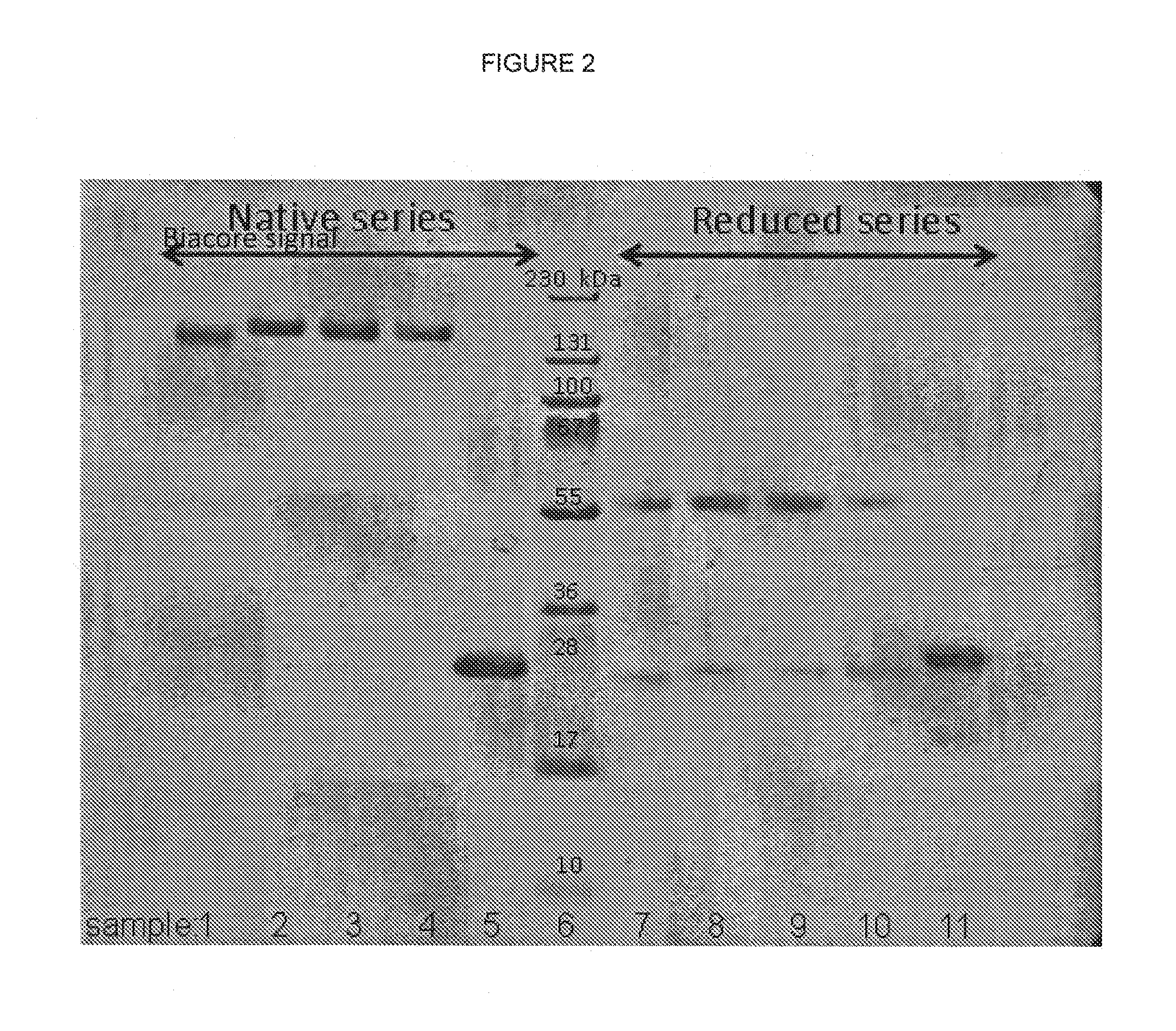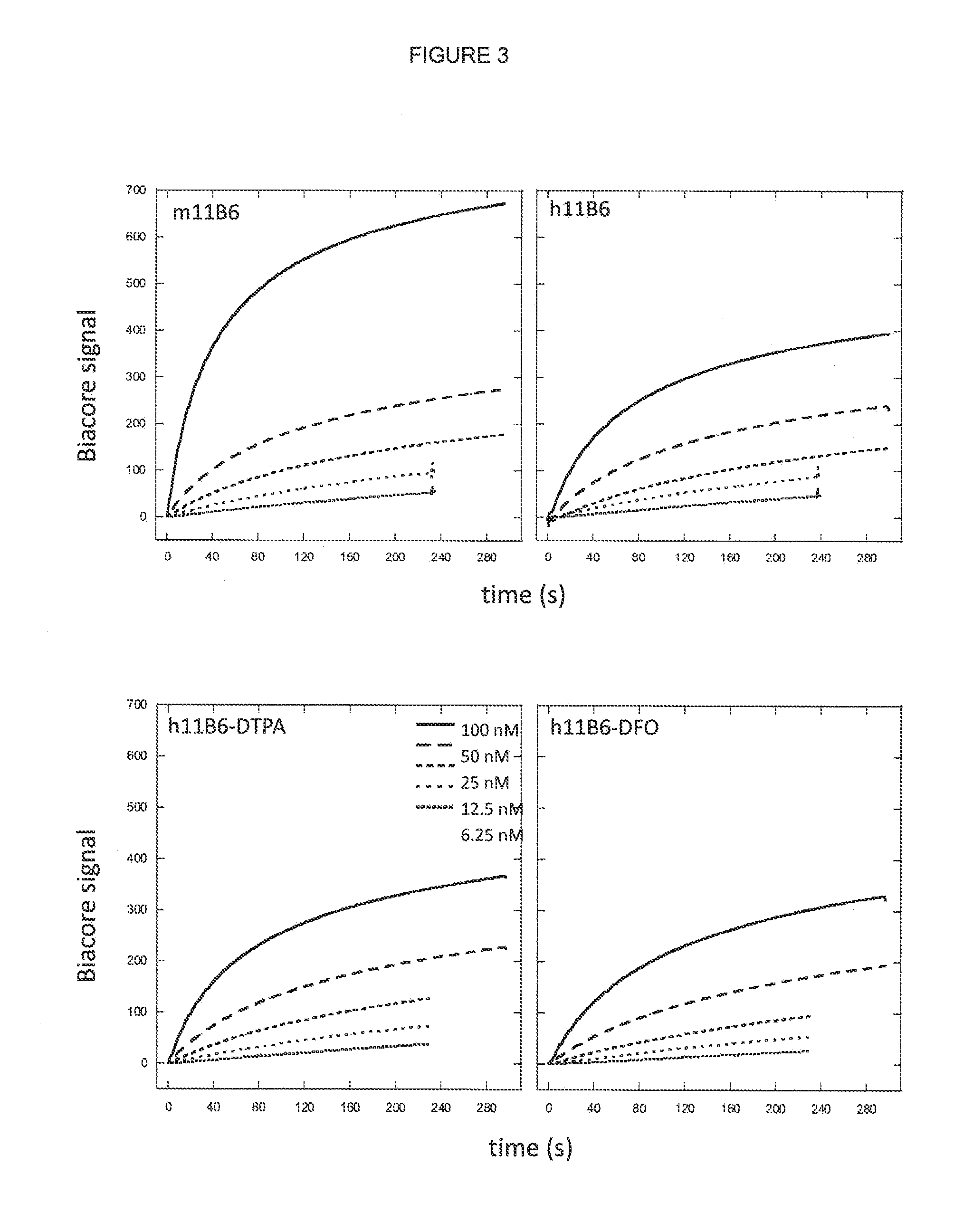Humanised anti kallikrein-2 antibody
a humanised, anti-kallikrein technology, applied in the field of humanised anti-kallikrein2 antibody, prostate cancer, can solve the problems of(or primarily) useful, achieve the effect of reducing the immunogenicity of monoclonal antibodies, reducing side effects or collateral damage, and reducing the side effects of side effects
- Summary
- Abstract
- Description
- Claims
- Application Information
AI Technical Summary
Benefits of technology
Problems solved by technology
Method used
Image
Examples
example 1
Cloning of 11B6 from Hybridoma Cell Line
Reagents
[0222]Monoclonal antibody 11B6 producing hybridoma cell line was used for mRNA extraction and production of antibodies which were further affinity purified for protein sequencing (Väisänen et al., 2004).
[0223]Restriction enzymes, FastAP and T4 DNA ligase were from Fermentas, primers from the University of Turku, Department of Biotechnology (W0252) and from Thermo Scientific. DNA purifications were done with Qiagen's Gel extraction and PCR purification kits.
mRNA Extraction and cDNA Synthesis
[0224]mRNA was extracted from 11B6 MAb producing hybridoma cells (5E6 cells) with QuickPrep Micro mRNA purification kit (Amersham Biosciences) and cDNA synthesis from the mRNA was done with Applied Biosystems' High-capacity cDNA archive kit according to instructions.
Amplification of Antibody Genes from cDNA
[0225]N-terminal sequences of the purified 11B6 MAb heavy (H) and light (L) chains were determined by Edman degradation at the University of Helsi...
example 2
Humanisation of the 11B6 Antibody
[0239]The variable domain of the murine anti-hK2 antibody11B6 was humanised using CDR-grafting method. In this approach, the complementarity determining regions (CDR) of the murine antibody were grafted to the variable heavy and light domain frameworks. In addition residues at CDR regions, the residues in the certain critical positions at the framework regions were retained as murine-like rather than turned to human-like in order to maintain the conformation of grafted CDR loops as similar as possible to their conformation in the parental murine antibodies.
[0240]Kabat numbering scheme (Kabat et al., 1991) is used throughout this description.
Homology Modelling
[0241]An homology model of the murine 11B6 antibody was generated by using automatic Web antibody modelling—Server (VAM; http: / / antibody.bath.ac.uk / index.html). The model was used for visual inspection based evaluation of the importance of the residues differing in between the parental murine ant...
example 3
Expression and Purification of h11B6
[0253]HEK293 cells were expanded in to a 2 L suspension culture in FreeStyle 293 Expression Medium (Life Technologies). The cell density was on the day for transfection 1×106 cells / ml.
[0254]The nucleotide sequences encoding the component heavy or light chains (i.e. SEQ ID NOs: 14 and 15, respectively) were codon-optimized for expression in mammalian cells, synthesized and cloned to IgG expression vectors. The plasmid DNA (expression vector) containing the nucleotide sequences for the heavy and light chains was then mixed with the transfection agent and incubated for 10 min in RT. The DNA-transfection agent-mix was slowly added to cell culture while slowly swirling the flask. The transfected cell culture was then incubated at 37° C., 8% CO2 on an orbital shaker platform rotating at approx. 135 rpm, for seven days.
[0255]Culture medium was harvest by centrifugation and filtered through 5 μm, 0.6 μm and 0.22 μm filter systems.
[0256]Antibodies were pur...
PUM
| Property | Measurement | Unit |
|---|---|---|
| Ratio | aaaaa | aaaaa |
| Cytotoxicity | aaaaa | aaaaa |
| Light | aaaaa | aaaaa |
Abstract
Description
Claims
Application Information
 Login to View More
Login to View More - R&D
- Intellectual Property
- Life Sciences
- Materials
- Tech Scout
- Unparalleled Data Quality
- Higher Quality Content
- 60% Fewer Hallucinations
Browse by: Latest US Patents, China's latest patents, Technical Efficacy Thesaurus, Application Domain, Technology Topic, Popular Technical Reports.
© 2025 PatSnap. All rights reserved.Legal|Privacy policy|Modern Slavery Act Transparency Statement|Sitemap|About US| Contact US: help@patsnap.com



